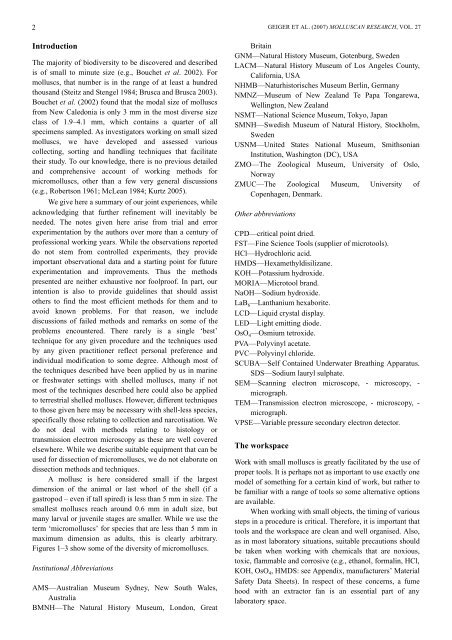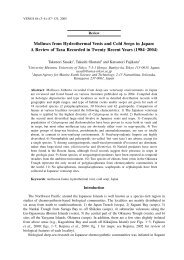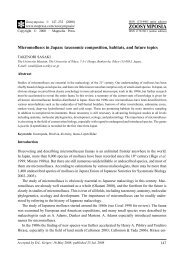Molluscan Research: Techniques for collecting, handling, preparing ...
Molluscan Research: Techniques for collecting, handling, preparing ...
Molluscan Research: Techniques for collecting, handling, preparing ...
You also want an ePaper? Increase the reach of your titles
YUMPU automatically turns print PDFs into web optimized ePapers that Google loves.
2<br />
Introduction<br />
The majority of biodiversity to be discovered and described<br />
is of small to minute size (e.g., Bouchet et al. 2002). For<br />
molluscs, that number is in the range of at least a hundred<br />
thousand (Steitz and Stengel 1984; Brusca and Brusca 2003).<br />
Bouchet et al. (2002) found that the modal size of molluscs<br />
from New Caledonia is only 3 mm in the most diverse size<br />
class of 1.9–4.1 mm, which contains a quarter of all<br />
specimens sampled. As investigators working on small sized<br />
molluscs, we have developed and assessed various<br />
<strong>collecting</strong>, sorting and <strong>handling</strong> techniques that facilitate<br />
their study. To our knowledge, there is no previous detailed<br />
and comprehensive account of working methods <strong>for</strong><br />
micromolluscs, other than a few very general discussions<br />
(e.g., Robertson 1961; McLean 1984; Kurtz 2005).<br />
We give here a summary of our joint experiences, while<br />
acknowledging that further refinement will inevitably be<br />
needed. The notes given here arise from trial and error<br />
experimentation by the authors over more than a century of<br />
professional working years. While the observations reported<br />
do not stem from controlled experiments, they provide<br />
important observational data and a starting point <strong>for</strong> future<br />
experimentation and improvements. Thus the methods<br />
presented are neither exhaustive nor foolproof. In part, our<br />
intention is also to provide guidelines that should assist<br />
others to find the most efficient methods <strong>for</strong> them and to<br />
avoid known problems. For that reason, we include<br />
discussions of failed methods and remarks on some of the<br />
problems encountered. There rarely is a single ‘best’<br />
technique <strong>for</strong> any given procedure and the techniques used<br />
by any given practitioner reflect personal preference and<br />
individual modification to some degree. Although most of<br />
the techniques described have been applied by us in marine<br />
or freshwater settings with shelled molluscs, many if not<br />
most of the techniques described here could also be applied<br />
to terrestrial shelled molluscs. However, different techniques<br />
to those given here may be necessary with shell-less species,<br />
specifically those relating to collection and narcotisation. We<br />
do not deal with methods relating to histology or<br />
transmission electron microscopy as these are well covered<br />
elsewhere. While we describe suitable equipment that can be<br />
used <strong>for</strong> dissection of micromolluscs, we do not elaborate on<br />
dissection methods and techniques.<br />
A mollusc is here considered small if the largest<br />
dimension of the animal or last whorl of the shell (if a<br />
gastropod – even if tall spired) is less than 5 mm in size. The<br />
smallest molluscs reach around 0.6 mm in adult size, but<br />
many larval or juvenile stages are smaller. While we use the<br />
term ‘micromolluscs’ <strong>for</strong> species that are less than 5 mm in<br />
maximum dimension as adults, this is clearly arbitrary.<br />
Figures 1–3 show some of the diversity of micromolluscs.<br />
Institutional Abbreviations<br />
AMS—Australian Museum Sydney, New South Wales,<br />
Australia<br />
BMNH—The Natural History Museum, London, Great<br />
GEIGER ET AL. (2007) MOLLUSCAN RESEARCH, VOL. 27<br />
Britain<br />
GNM—Natural History Museum, Gotenburg, Sweden<br />
LACM—Natural History Museum of Los Angeles County,<br />
Cali<strong>for</strong>nia, USA<br />
NHMB—Naturhistorisches Museum Berlin, Germany<br />
NMNZ—Museum of New Zealand Te Papa Tongarewa,<br />
Wellington, New Zealand<br />
NSMT—National Science Museum, Tokyo, Japan<br />
SMNH—Swedish Museum of Natural History, Stockholm,<br />
Sweden<br />
USNM—United States National Museum, Smithsonian<br />
Institution, Washington (DC), USA<br />
ZMO—The Zoological Museum, University of Oslo,<br />
Norway<br />
ZMUC—The Zoological Museum, University of<br />
Copenhagen, Denmark.<br />
Other abbreviations<br />
CPD—critical point dried.<br />
FST—Fine Science Tools (supplier of microtools).<br />
HCl—Hydrochloric acid.<br />
HMDS—Hexamethyldisilizane.<br />
KOH—Potassium hydroxide.<br />
MORIA—Microtool brand.<br />
NaOH—Sodium hydroxide.<br />
LaB 6 —Lanthanium hexaborite.<br />
LCD—Liquid crystal display.<br />
LED—Light emitting diode.<br />
OsO 4 —Osmium tetroxide.<br />
PVA—Polyvinyl acetate.<br />
PVC—Polyvinyl chloride.<br />
SCUBA—Self Contained Underwater Breathing Apparatus.<br />
SDS—Sodium lauryl sulphate.<br />
SEM—Scanning electron microscope, - microscopy, -<br />
micrograph.<br />
TEM—Transmission electron microscope, - microscopy, -<br />
micrograph.<br />
VPSE—Variable pressure secondary electron detector.<br />
The workspace<br />
Work with small molluscs is greatly facilitated by the use of<br />
proper tools. It is perhaps not as important to use exactly one<br />
model of something <strong>for</strong> a certain kind of work, but rather to<br />
be familiar with a range of tools so some alternative options<br />
are available.<br />
When working with small objects, the timing of various<br />
steps in a procedure is critical. There<strong>for</strong>e, it is important that<br />
tools and the workspace are clean and well organised. Also,<br />
as in most laboratory situations, suitable precautions should<br />
be taken when working with chemicals that are noxious,<br />
toxic, flammable and corrosive (e.g., ethanol, <strong>for</strong>malin, HCl,<br />
KOH, OsO 4 , HMDS: see Appendix, manufacturers’ Material<br />
Safety Data Sheets). In respect of these concerns, a fume<br />
hood with an extractor fan is an essential part of any<br />
laboratory space.




